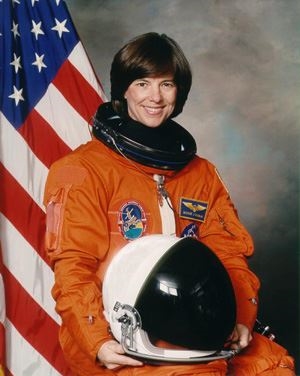 |
| Bonnie Dunbar (http://www.nasa.gov) |
Bonnie Dunbar grew up in the small town of Sunnyside, Washington, before moving to Seattle and going to the University of Washington. At the University of Washington she earned her bachelor’s degree in science and her master’s degree in ceramic engineering; later she received her doctorate in mechanical/biological engineering from the University of Houston.
Bonnie Dunbar worked at a variety of corporations (including Boeing, Harwell Laboratories, and Rockwell International Space Division) in fields such as physiology and aeronautics. In California, she even worked on a space shuttle thermal protection plan. Dunbar is an accomplished pilot, which qualified her in becoming a payload officer at the Lyndon B. Johnson Space Center. Joining NASA in 1981, she began her journey as an astronaut.
Bonnie Dunbar has been an officer on five space missions, spending more than fifty days in space. Her first mission was aboard the STS 61-A Challenger, which was the first space flight to carry a full eight-person crew. Dunbar’s second mission included launching a satellite (Syncom IV-F5) from shuttle, STS-32 Columbia. By her third mission, Dr. Dunbar had become the Payload Commander, putting her in charge of a four-man crew (a payload is complementary equipment for a mission or experiment). The crew spent thirteen days in space performing experiments on crystal growth, human physiology, and surface tension physics. Dunbar was also aboard the STS-71 Atlantis, the first shuttle to dock with Mir, the Russian Space Station. In her last space mission, the STS-89 Endeavor transferred 9,000 pounds of equipment to Mir (NASA).
When the President of the Museum of Flight retired, Bonnie Dunbar applied for the position. The Executive Committee of the Museum’s Board of Trustees viewed applications for a year before settling on Dunbar’s. Her experience in various fields made her an outstanding applicant and just what the Board of Trustees was looking for (Museum of Flight). As President and CEO of the Museum of Flight, Dunbar has helped organize the Washington Aerospace Scholars (WAS), a scholars program through NASA focusing on aeronautics and engineering. With the help of Governor Christine Gregoire and much support from NASA, Dunbar helped start the program in Washington like the original Aerospace Scholars in Texas. I, myself, was a part of the inaugural class of the Washington Aerospace Scholars. During the week-long residency, we listened to many speakers; these speakers ranged from aeronautical engineers to robotics engineers to astronauts and even the governor.
Bonnie Dunbar has accomplished more in her life than most will. She has worked tremendously hard to accomplish her dreams, as well as the dreams of NASA. Dunbar has been to space, as well as flown more than 1,300 hours as a pilot and co-pilot. She has led experiments while in space, been in charge of payload missions, helped design a space shuttle thermal protection plan, and was aboard the first shuttle to dock with Mir. Having met Ms. Dunbar, I can say that she is gracious and humble, as well as optimistic for the future of space travel. I think Bonnie Dunbar’s contributions will be greatly appreciated and a huge part of space travel in the future.
Page created on 8/29/2011 12:00:00 AM
Last edited 1/9/2017 9:37:38 PM
